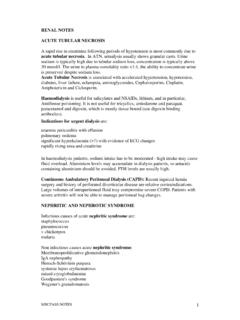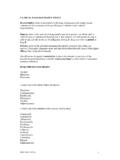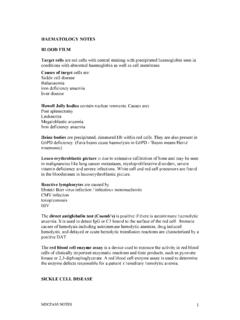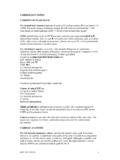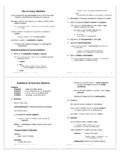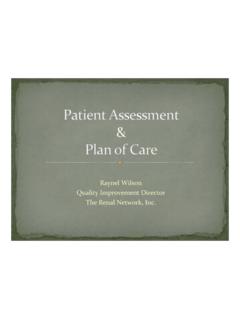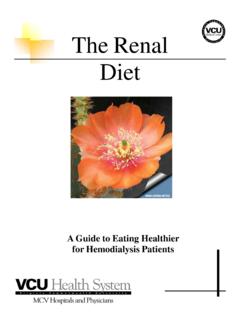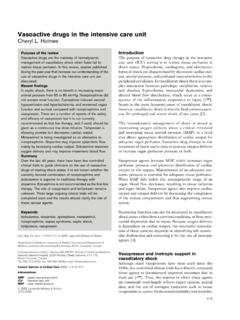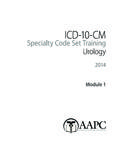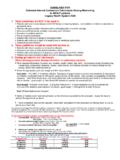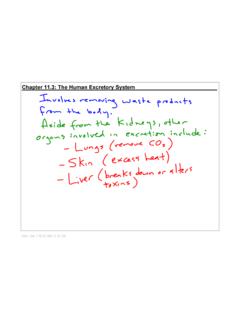Transcription of CARDIOLOGY NOTES CARDIOVASCULAR EXAM reversal of …
1 CARDIOLOGY NOTES CARDIOVASCULAR EXAM The second heart sound comprises of aortic (A2) and pulmonary (P2) component. In LBBB, the aortic closure is delayed because the left ventricle contracts later. This then causes reversed splitting (A2P2 P2A2) if the second heart sound. LBBB and left heart strain in HCM and aortic stenosis can cause reversal of A2P2 second heart sounds. Also, in type B wolf parkinson white syndrome, early activation of the right ventricle through an accessory pathway can cause P2 to close prematurely. Patent ductus arteriosus is another cause. The third heart sound is caused by early diastolic filling due to ventricular relaxation, shortly after closure of the aortic valve (corresponds to Y descent in JVP). It may be normal in children and young /middle aged adults.
2 Causes of an abnormal third heart sound are: Left ventricular failure Severe MR and TR VSD, PDA Constrictive pericarditis Hypertrophic cardiomyopathy Dilated cardiomyopathy AV fistula thyrotoxicosis Causes of an abnormal fourth heart sound are: Causes of raised JVP are: Congestive cardiac failure SVC obstruction Constrictive pericarditis Anaemia Tricuspid regurgitation Pulsus paradoxus is defined as an inspiratory systolic fall in arterial pressure of 10mmHg. It not only occurs in cardiac tamponade, but also in massive PE, severe COPD and hypotension/shock. Cannon a waves occur when the atria and ventricles contract at the same time. The causes are complete AV block, ventricular tachycardia and AV nodal reentry tachycardia CARDIAC ANATOMY The left internal mammary artery supplies the anterior chest wall.
3 It has been shown to be superior to saphenous vein grafts (from aorta to LAD) in staying patent and hence is now the choice artery (LIMA to LAD) graft. Although circumflex and right coronary arteries are usually grafted with veins, the right internal mammary arteries (RIMA) are sometimes used to graft the RCA. MRCPASS NOTES 1 The circumflex artery gives off obtuse marginal branches and the LAD gives off diagonal branches. The intermediate artery is not always present, it is a variant artery which is between the LAD and circumflex artery, and occasionally dominant instead of the circumflex. The coronary sinus predominantly drains venous blood from the left ventricle and receives approximately 85 percent of coronary venous blood. It receives blood from the the marginal, posterior left ventricular, anterior interventricular veins and the great cardiac vein.
4 The blood finally drains into the right atrium. The posterior descending artery is often (85%) a branch of the right coronary artery. The sinus node artery is a branch of the right coronary artery in 60% of cases. The AV node is supplied by the posterior descending coronary artery. ARRHYTHMIAS Atrial flutter most commonly presents with 2:1 block, which means atrial rate of 300 but ventricular rate of 150. Ischaemic chest pain may occur due to the tachycardia. Carotid sinus massage can sometimes terminate or slow the tachycardia. DC cardioversion should be performed if the patient is cardivascularly unstable. Atrial flutter is commoner in patients with dilated left atrium or in congenital/structural heart disease. Differentiating SVT from VT Features that favour VT are : QRS of > 140ms, cannon a waves on JVP fusion and/or capture beats dissociated p waves, history of ischaemic heart disease, right bundle branch block with left axis deviation, concordance of the QRS complexes in the chest leads HR >170 beats per minute.
5 In a patient who is stable with sustained ventricular tachycardia, the options are intravenous lignocaine, intravenous amiodarone. IV magnesium sulphate (18 / 20 mmols or 5g) is often helpful in helping to cardiovert. If the patient were unstable then he needs to be DC cardioverted immediately (with or without general anaesthetic). The criteria for ICD insertion are: 1) patients with LVEF <40% with non sustained VT MRCPASS NOTES 22) patients with sustained VT 3) patients who have had any VT or VF leading to cardiac arrest 4) cardiomyopathy and ventricular arrhythmias 5) patients with previous MI and ejection fraction <30% The MADIT II trial showed that in patients with a previous MI and reduced left ventricular ejection fraction (<30%), the prophylactic use of an ICD, in addition to medications, significantly reduced the risk of death.
6 The first form of second degree heart block, Mobitz type I (Wenkebach) is due to progressive prolongation of PR interval and then missing a beat. Mobitz type II second degree heart block can occur with 2:1 (only 1 QRS is conducted for 2 p waves) or 3:1. RBBB (not LBBB) with left anterior hemiblock (or left axis deviation) is called bifascicular block. If first degree heart block was also present, then it is known as trifascicular block. PROLONGED QT A QT interval of > is prolonged. DRUGS causing PROLONGED QT tricyclic antidepressants (eg. amitryptiline) quinidine, erythromycin, amiodarone, phenothiazines (chlorpropramide), antihistamines (terfenadine) grapefruit juice sotalol METABOLIC causes of PROLONGED QT Hypokalaemia Hypocalcaemia Hypomagnesaemia Hypothermia Hypothyroidism A dominant R in lead V1 on the ECG is associated with : -primary pulmonary HT -Right bundle branch block (RBBB) (including Ebstein's anomaly -Wolf-Parkinson-White syndrome Type A -Dextrocardia -Posterior MI -Duchene muscular dystrophy MYOCARDIAL INFARCTION Absolute contraindications to thrombolysis include.)
7 Previous haemorrhagic stroke MRCPASS NOTES 3ischaemic CVA within 1 year suspected aortic dissection active bleeding <10 days BP>180/110 neurosurgical procedure < 6 months ago Relative contraindications include major surgery or bleeding within 6 weeks pregnancy known bleeding diathesis severe uncontrolled hypertension Proliferative diabetic retinopathy Troponins tend to be elevated for up to 14 days. CK-MB comes down to normal level within 48-72 hours, and is the most specific of the CK enzymes. Pulmonary embolus, arrhythmias, myocarditis and right heart disorders are also known to elevate troponins. HYPERLIPIDAEMIAS The characteristics of familial hypercholesterolaemia are: autosomal dominant condition increased LDL concentrations reduced HDL concentrations reduced numbers of LDL receptor CARDIOVASCULAR disease tendon xanthomatas In familial hypercholesterolaemia characteristically total cholesterol is > , LDL-cholesterol is > mmol/L and triglyceride is < mmol/L.
8 It is due to an LDL receptor defect. THE PRIMARY HYPERLIPIDAEMIAS: THE FREDERICKSON CLASSIFICATION Type II hyperlipidaemia the most common primary hyperlipidaemia. The picture is similar to familial hypercholesterolaemia but milder. It is characterised by increased levels of LDL-cholesterol (> mmol/L). Triglyceride levels are < mmol/L. Type IIa hypercholesterolaemia causes heart disease as there is predominantly raised cholesterol and high LDL. There is also increased triglycerides cause eruptive skin xanthomas, lipaemia retinalis (white TG deposits in the retina) and pancreatitis. Cholesterol has an affinity for deposition around the tendons, tendon xanthoma is characteristic of hypercholesterolaemia. Type II b hypercholesterolaemia also causes elevated cholesterol and triglycerides.
9 Type III hyperlipidemia is when cholesterol and triglyceride are both increased, and is associated with atherogenesis. Homozygosity for the E2 genotype (E2/E2) is found in most patients with type III hyperlipidemia. The palmar striae (palmar xanthomata) are considered pathognonomic for the disorder and occur in less than 50% of patients but tubero-eruptive xanthomata, typically on the elbows and knees, as MRCPASS NOTES 4well as xanthelasma have been described. The underlying biochemical defect is one of a reduced clearance of chylomicron and VLDL remnants. Type IV hyperlipidemia causes an isolated hypertrigIVceridaemia. There is normal or slightly raised plasma cholesterol. There are increased triglyceride levels due to increased VLDLs Type I and V hyperlipidaemia have lipoprotein lipase defects, and lead to raised chylomicrons and triglyceride levels.
10 Eruptive xanthomas in the skin are typical of triglyceridaemia. Alcohol abuse, pancreatitis and hypertriglyceridaemia are associated. Both type I and type IV are triglyceridaemic states. Triglycerides cause turbid serum. List of causes of raised triglycerides are: nephrotic syndrome hypothyroidism biliary obstruction steroids diabetes mellitus renal failure thiazide diuretics oral contraceptive pill lipodystrophies and glycogen storage disease (Von Gierke's) Chylomicrons are triglyceride-rich lipoproteins (75%-95% of their core lipid is triglyceride) made in the small intestine from ApoB-48 (apoliproprotein). VLDL are made in the liver from ApoB-100. Ventricular septal defect (VSD) is the commonest form of congenital heart disease. Maladie de Roger is a loud systolic murmur despite a small VSD.
